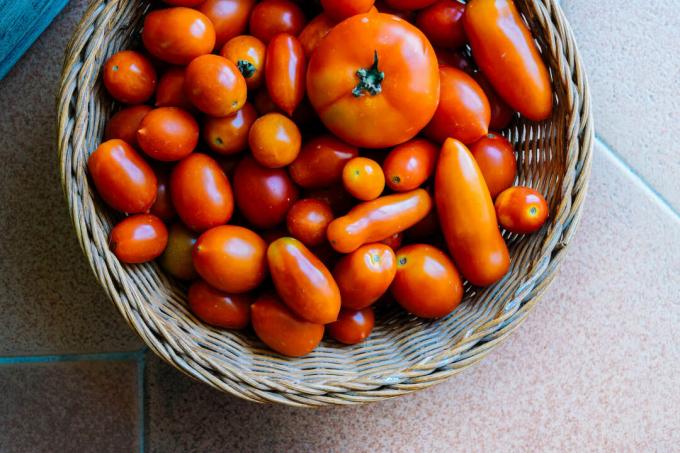We show everything from the tomato harvest to post-ripening and correct storage to canning and preservation of the delicious fruits.

Since we now almost exclusively know tomatoes from the supermarket around the corner, it is difficult for us to assess the correct degree of ripeness. If you have the luxury of growing tomatoes in your own garden, you should also use it to harvest the tomatoes when they are ripe. This gives the plant enough time to invest energy in the aroma of the fruit. First of all: There are also situations in which you should harvest the tomatoes unripe or before they are fully ripe. But more on that later.
contents
- Correctly determine the degree of ripeness of tomatoes
- Ripe unripe tomatoes and store them properly
- Preserving: Preserving tomatoes
Correctly determine the degree of ripeness of tomatoes
The tomato harvest here in the country usually begins at the end of July. With ripe tomatoes, the color of the skin is strongly developed. Fruits and the sepals at the fruit set give off some intense and pleasant scent. Meat and ox heart tomatoes in particular now give a little under pressure. If these factors apply, we recommend harvesting. Tomatoes love sun and warmth, so they shouldn't be stored in the refrigerator, but in a cool, dark place. This way they can be kept for a few days.

Ripe unripe tomatoes and store them properly
As already indicated above, there are also moments when you should harvest almost ripe tomatoes early. The most obvious case is autumn before the first night frosts are due. But also before announced and extended rain phases or an upcoming vacation can be harvested. Tomatoes ripen well. On the one put the fruits on a dry and light window sill and provide a soft moisture-absorbing surface (kitchen towel, etc.).

After two to three weeks, the fruits will ripen and should no longer be green. If the tomatoes are still green, even though they are varieties that should actually be red or yellow, consumption is not recommended. Unripe fruits and other parts of the plant contain the poisonous solanine. Small amounts of the alkaloid make your throat scratchy. Higher doses can lead to vomiting, cramps and, in extreme cases, death. As long as you don't eat green tomatoes in large quantities, however, you are on the safe side. Small children tolerate solanine worse, which is why you should definitely remove the tomato stalk.
Preserving: Preserving tomatoes
Once you've got a taste for home-grown tomatoes, you can't get enough. However, the harvest can sometimes quickly exceed one's own needs. The popular vegetable can be preserved in different ways. One of the best-known is probably the drying: Especially in the Mediterranean countries you can often see tomato halves drying in the sun. In grandmother's time, the excess harvest was also often harvested or harvested. awakened. Preserving and pickling works well if you don't like the slightly firmer texture of sun-dried tomatoes. If you often need tomatoes for cooking, freezing or preserving them is also a good option. In our article on the Preserving tomatoes learn more details.

Did you know that tomatoes are perennial plants? You can find out how to do this in our special article Hibernate tomatoes can.



